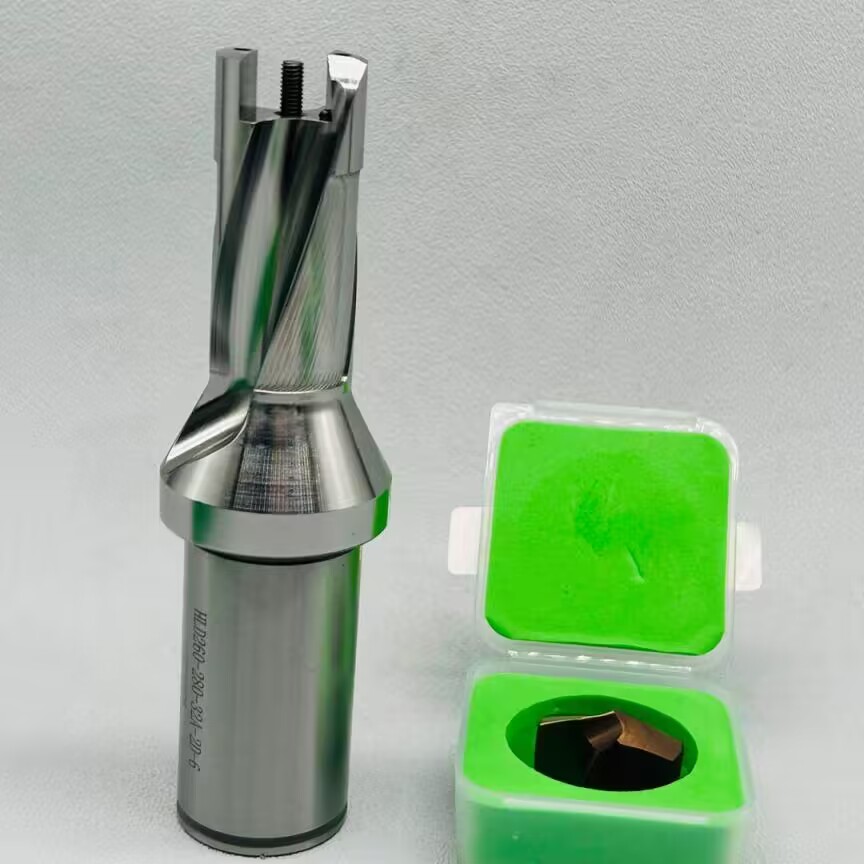The Carbide Spade Drill is an improved tool based on U-drill. The equipment used has a wide range (can be used in equipment such as rocker drills, vertical drills, horizontal beds, machining centers, etc.), and the rigidity requirements for the equipment are not high. The overall cutting head can be accurately centered, and the cutting head is equipped with chip separation grooves and chip breaking grooves, which can process deep holes.
The Spade Drill are generally used for intermediate speed machining between U-drill machining and ordinary drill bit machining. Generally, the blade is made of high-speed steel, and the rotational speed is generally below 1000 rpm. Compared with ordinary drill bits, it does not require blade grinding and requires lower skills from workers.
The Spade Drill is composed of a steel cutterhead and a blade with a replaceable head. The handle of the blade has two structures: a side fixed handle and a Morse handle. Side fixed handle tool holders are commonly used in CNC lathes, machining centers, CNC machine tools, etc. The Morse handle is used in traditional equipment such as vertical drills, rocker drills, and conventional drills. By simply installing a cooling ring device, the transition from external cooling to internal cooling can be achieved. Cooling water enters the blade through the cooling ring and is directly cooled to the blade section through the internal cooling hole. And high-pressure cooling water is more conducive to chip removal.
There are two forms of chip removal for the tool holder: straight groove and spiral groove. When the workpiece rotates and the tool is stationary, straight grooves are more conducive to chip removal, such as in lathe machining. When the tool is stationary while rotating the workpiece at high speed, spiral chip slots are more commonly chosen, such as CNC machine tools, rocker drills, etc. According to the length to diameter ratio of the tool holder, it can be divided into 3D, 5D, 7D, 9D or even higher.
The blade of the carbide Spade drill is divided into two types: hard alloy of carbide blade and high-speed steel blade. The range of hard alloy carbide blades is from 9mm to 32mm. The range of high-speed steel blades ranges from 9mm to 68mm, and some non-standard blades can even be made larger. High speed steel blades are generally M42 high-speed steel with cobalt content of 8%, which has good wear resistance and toughness.
The Spade drilling blade is positioned through a groove, and two screw holes are fixed in both directions, ensuring that the symmetry of the blade is between 0.01 and 0.02mm. According to the size of the blade, there are generally 2-6 chip breaking grooves. According to the different cutting materials, the top of the blade is an X-shaped drill tip or an S-shaped drill tip.
Advantages of Spade drilling tool:
Easy to drill deep holes with multiple diameters. The blade adopts a symmetrical structure of center centered double-edge cutting, so it can drill deep holes up to even 20D. Ordinary U-drills and shallow drills cannot drill deep holes, which can be completed by shovel drills.
The Spade drills can be widely used in traditional machine tools such as rocker drills. Traditional machine tools, due to their low spindle speed, poor rigidity, and weak power, cannot be used with conventional fast drills, U-drills, and other drills equipped with hard alloy blades. The shovel drill uses high-speed steel coated blades containing cobalt, which have high toughness and impact resistance, and can effectively solve the problem of blade breakage.
The drilling accuracy of Spade drills is much higher than that of U-drills. A U-drill is a tool that installs two asymmetric cutting blades. When the cutting body cuts into the surface of the workpiece, the axial force acting on the outer and inner cutting edges of the cutting body is uneven, which inevitably causes changes in size. Therefore, U-drills can only be used as rough machining tools with an accuracy of ± 0.1mm. The Spade drill blade can cut symmetrically, and the dimensional accuracy can be controlled within 5 threads. Directly drilling can meet the requirements of threaded bottom holes. The side of the Spade drill blade has a polishing blade strip, and through the squeezing of the polishing blade strip, the smoothness of the processed hole wall can reach RA1.6.
